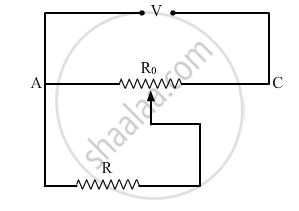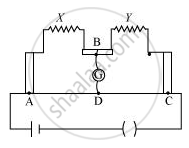Advertisements
Advertisements
Question
In a meter bridge, the null point is found at a distance of l1 cm from A. If now a resistance of X is connected in parallel with S, the null point occurs at l2 cm. Obtain a formula for X in terms of l1, l2 and S.

Solution
Initially, when X is not connected
`R/S = l_1/(100 -l_1)` [Condition for balance ] ....... (1)
The equivalent resistance (Req) of the combination of X and S is
`1/R_(eq) = 1/X +1/S`
`R_(eq) = (SX)/(X+S)`
`R/R_(eq) = (l_2)/(100 - l_2)`
`(R(X+S))/(SX) = (l_2)/((100 - l_2))` ........ (2)
On dividing (i) by (ii), we obtain
`R/(R(X +S)) xx (SX)/X = (l_1(100 - l_2))/(l_2(100 - l_1)) `
`X /(X +S) = (l_1(100 - l_2))/(l_2(100-l_1)`
`Xl_2 (100 - l_1) = (X +S)l_1(100 - l_2)`
`XI_2 (100 - l_1) = Xl_1(100 - l_2) + Sl_1 (100 - l_2)`
`X = (Sl_1 (100 - l_2))/([l_2(100 -l_1) - l_1 (100 - l_1)])`
This is the expression for X in terms of S, l1 and l2.
APPEARS IN
RELATED QUESTIONS
State any ‘two’ possible sources of errors in meter-bridge experiment. How can they be minimised?
A cell balances against a length of 200 cm on a potentiometer wire, when it is shunted by a resistance of 8Ω. The balancing length reduces by 40 cm, when it is shunted by a resistance of 4 Ω . Calculate the balancing length when the cell is in open circuit. Also calculate the internal resistance of the cell.
Why are the connections between the resistors in a meter bridge made of thick copper strips?
Why is it generally preferred to obtain the balance point in the middle of the meter bridge wire?
Which material is used for the meter bridge wire and why?
A resistance of R Ω draws current from a potentiometer as shown in the figure. The potentiometer has a total resistance Ro Ω. A voltage V is supplied to the potentiometer. Derive an expression for the voltage across R when the sliding contact is in the middle of the potentiometer.

Write the principle of working of a metre bridge

The figure shows experimental set up of a meter bridge. When the two unknown resistances X and Y are inserted, the null point D is obtained 40 cm from the end A. When a resistance of 10 Ω is connected in series with X, the null point shifts by 10 cm. Find the position of the null point when the 10 Ω resistance is instead connected in series with resistance ‘Y’. Determine the values of the resistances X and Y.
In a meter bridge experiment, resistance are connected as shown in figure, The balancing length 1, is 55 cm. Now an unknown resistance x is connected in series with P and new balancing length is found to be 75cm. The value of x is ______.

In a sensitive meter bridge apparatus the bridge wire should possess ______.
